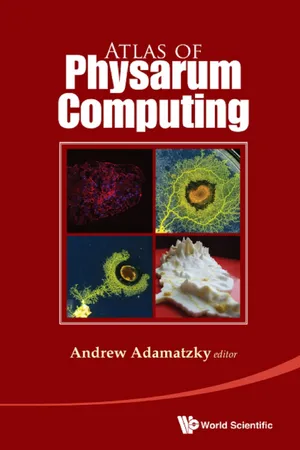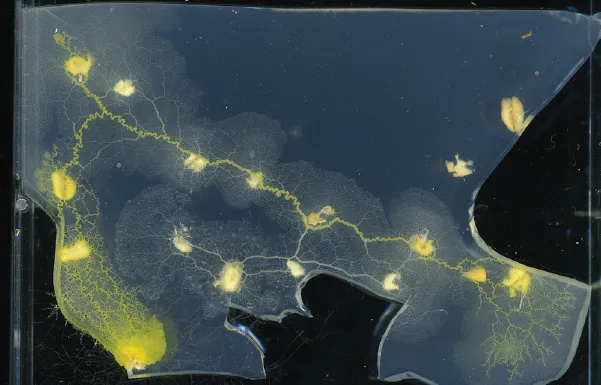
- 128 pages
- English
- ePUB (mobile friendly)
- Available on iOS & Android
Atlas Of Physarum Computing
About this book
The slime mould Physarum polycephalum is a large cell visible by the unaided eye. It behaves as an intelligent nonlinear spatially extended active medium encapsulated in an elastic membrane. The cell optimises its growth patterns in configurations of attractants and repellents. This behaviour is interpreted as computation. Numerous prototypes of slime mould computers were designed to solve problems of computational geometry, graphs and transport networks and to implement universal computing circuits.
In this unique set of scientific photographs and micrographs, the leading experts in computer science, biology, chemistry and material science illustrate in superb detail the nature of the slime mould computers and hybrid devices. Every photograph or micrograph in this book is of real scientific, theoretical or technological interest. Each entry includes a self-contained description of how the visualised phenomenon is used in the relevant slime mould computer.
This atlas is unique in providing the depth and breadth of knowledge in harnessing behaviour of the slime mould to perform computation. It will help readers to understand how exploitation of biological processes has sparked new ideas and spurred progress in many fields of science and engineering.
Contents:
- Slime Mould Gates, Roads and Sensors (Andrew Adamatzky)
- Multi-Agent Model of Slime Mould for Computing and Robotics (Jeff Jones)
- Slime Mould Biotechnology (Richard Mayne)
- Slime Mould Interactions with Chemicals and Materials (Benjamin De Lacy Costello)
- Basic Features of Slime Mould Motility (Tomohiro Shirakawa)
- Slime Mould Grown on Polymer Layers (Alice Dimonte, Tatiana Berzina and Victor Erokhin)
- Diversity of Slime Mould Circuits (Martin Grube)
- Slime Mould Fluids and Networks from an Artist's Point of View (Theresa Schubert)
Readership: Students and researchers interested in biological processes and computing.
Key Features:
- Full of interesting photos and illustrations, which appeal not only to experts but to laymen and general public
- The contents are of real scientific, theoretical, or technological interest — guaranteed to make every geek's heart pound a little faster
- A unique compilation of new knowledge and its integration with existing information
- The Atlas provides a concise review of each thematic unit, with spreads of color illustrations and accompanying text that allows for speedy comprehension of key concepts
- All topics related to the slime mould are not covered well in mass media (newspapers, TV, pop-sci films and documentaries); therefore, the publication of the Atlas will be met warmly and is expected to attract huge support of academic and public outreach communities
Frequently asked questions
- Essential is ideal for learners and professionals who enjoy exploring a wide range of subjects. Access the Essential Library with 800,000+ trusted titles and best-sellers across business, personal growth, and the humanities. Includes unlimited reading time and Standard Read Aloud voice.
- Complete: Perfect for advanced learners and researchers needing full, unrestricted access. Unlock 1.4M+ books across hundreds of subjects, including academic and specialized titles. The Complete Plan also includes advanced features like Premium Read Aloud and Research Assistant.
Please note we cannot support devices running on iOS 13 and Android 7 or earlier. Learn more about using the app.
Information
University of the West of England, Bristol, United Kingdom
[email protected]


Table of contents
- Cover Page
- Title Page
- Copyright Page
- Contents
- Preface
- Acknowledgements
- 1. Slime mould gates, roads and sensors
- 2. Multi-agent model of slime mould for computing and robotics
- 3. Slime mould biotechnology
- 4. Slime mould interactions with chemicals and materials
- 5. Basic features of slime mould motility
- 6. Slime mould grown on polymer layers
- 7. Diversity of slime mould circuits
- 8. Slime mould fluids and networks from an artist’s point of view
- Bibliography
- Index